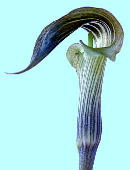The Arum Family

|  |
| Arisaema triphyllum spp. |
Lysichiton camtschatcense spp. |
| Jack-in-the-Pulpit |
Japanese skunk cabbage |
The Araceae are perennial herbs, often terrestrial or climbing via adventitious root, rarely floating aquatic (Pistia.)
Many taxa have extended their tropical range into temperate offices and homes as foliage ornamentals
while most are found tropical and subtropical areas. The Araceae comprise approximately 110 genera and 2800 species.
Click here for a distribution map of the Araceae in the U.S.A.
Vegetative Characters | Reproductive Characters |
Diagnostic Characters | Economic Importance/Fun Facts
| Evolutionary Adaptations and Relationships | Glossary of Terms |
References and Links | Pictures
- Usually basal leaves, simple or compound, with a sheathing petiole
- Leaves small to very large, most often alternate, can be spiral or distichous
- Venation parallel, pinnate or palmate
- Sometimes milky latex or watery pungent sap
- Tissues contain raphides
Back to top
- Reduced flowers usually organized into an inflorescence (Spadix) subtended by a bract (Spathe)
- Flowers perfect or imperfect (usually monoecious)
- Perianth nearly alway absent in unisexual flowers but in bisexual flowers consists of 4-6
small undifferentiated tepals that are free or connate
- Flowers actinomorphic
- Gynoecium typically consists of a single compond pistil of usually 3 but up to 15 carpels
- Superior ovary, hypogynous or epigynous
- Usually axile placentation
- Fruit usually a berry with a large embryo
Back to top
- Spathe and spadix
- Flowers usually not real good in helping to determine species
- In species with unisexual flowers, the male flowers are at the top and female flowers at the bottom of the spadix
Back to top
- Raphides can cause injury to mouth and throat if consumed
- Starchy corms or tubers can be used as a food source after being baked or boiled
- Hawaiian Poi comes from Taro (colocasia)
- Many species are used as ornamentals
- Some plants are poisonous
Back to top
- Monophyletic based on morphological characters such as inflorescence type (Zomlefer 1994)
- Closely related to the Lemnaceae family (duckweed)which was once considered part of Araceae family
- Considered to have evolved from liliaceous ancestors (Zomlefer 1994)
- Genus Acorus contains Araceae, Lemnaceae and Acoraceae
Back to top
- Spadix - infloredcence consisting of small closely packed flowers around a swollen, fleshy column
- Spathe - usually large petal-like bract wrapped around the base of a spadix
- Raphides - bundles of needle-like Calcium Oxalate crystals
- Distichous - two ranked
- Pungent - strong smelling
Back to top
- Judd, W. S., C. S. Campbell, E. A. Kellogg, P. S. Stevens. 1999. Plant Systematics: a phylogenetic approach. Sinauer Associates, Inc. Sunderland, MA U.S.A.
- Walters, D.R. and D.J. Keil, 1996. Vasccular Plant Taxonomy, Fourth Edition. Kendall/Hunt Publishing Co. Dubuque, IA 52002
- Zomlefer, Wendy B., 1994. Guide to Flowering Plant Families. The University of North Carolina Press Chapel Hill, NC USA.
- http://biodiversity.uno.edu/delta/angio/www/araceae.htm
- http://www.botany.hawaii.edu/faculty/carr/ar.htm
- http://www.aroid.org/genera/
- http://collections.ic.gc.ca/gardens/Horticulture/DetailedPlantInventory/Araceae.htm
- http://www.omnicyber.org/Bio/HTML/A/Araceae.html
- http://botit.botany.wisc.edu/courses/systematics/family_index/Family_Pages/Araceae.html
Back to top
 |
 |
| Lepidium bidendatum |
Brassica - flower cut-away showing 2+4 stamens |
 |
 |
| Dieffenbachia foliage |
|








